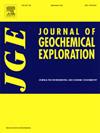Unconformity-related mineralization and fluid transfers in the northern Aquitaine Basin (France) revealed by fluid inclusions and S-Sr isotopes studies
IF 3.4
2区 地球科学
Q1 GEOCHEMISTRY & GEOPHYSICS
引用次数: 0
Abstract
In sedimentary basins, unconformity between basement and sediments is the ideal site where fluids from different sources can flow and mix, initiating the formation of ore deposits. In western Europe there are numerous F-Pb-Zn-Ba (±Ag, Ge) basin-hosted deposits located near the unconformity between Mesozoic Basins and the Variscan basement as for example the deposits of the Vendée Coast (France) containing fluorite, baryte, pyrite and quartz. Here, microthermometric data on the primary fluid inclusions of these minerals indicate salinity ranging from 1 to 20 wt% eq. NaCl and homogenization temperatures between 100 and 390 °C. We interpret these data as resulting of a fluids circulation in the ore deposit zone, with an early incursion of basin brines expelled by the leaching of Hettangian evaporites buried several tens of kilometers away, followed by an ascent of basement-derived fluids and, finally, a recharge of seawater. In other French deposits, the δ34S isotopes of baryte are also consistent with a source of fluids from buried evaporites. The 87Sr/86Sr ratio of baryte demonstrates a crustal source of elements associated with brines-leached base metals and F![]() Ba. The process of buried-derived evaporites brines altering the basement along the unconformity is ubiquitous in all unconformity deposits in France.
Ba. The process of buried-derived evaporites brines altering the basement along the unconformity is ubiquitous in all unconformity deposits in France.
With our results, we confirm that the basin deposits in the Southeastern Massif Central occur along structures formed during Tethys rifting at around 200 Ma, whereas in the Western part they form at ca. 145 Ma in link with the opening of the Bay of Biscay. This highlights that these basin-hosted deposits are preferentially formed during extensional activity in rifting settings, rather than in compressive settings.
流体包裹体和S-Sr同位素研究揭示了法国阿基坦盆地北部不整合相关的成矿作用和流体转移
在沉积盆地中,基底与沉积物之间的不整合是不同来源的流体流动和混合的理想场所,从而开始形成矿床。在西欧,在中生代盆地与Variscan基底的不整合面附近有大量含氟-铅锌-钡(±Ag, Ge)的盆地矿床,如法国vend海岸的含萤石、重晶石、黄铁矿和石英的矿床。在这里,这些矿物的原生流体包裹体的显微测温数据表明,盐度在1 - 20 wt% eq. NaCl之间,均一温度在100 - 390℃之间。我们将这些数据解释为矿床带流体循环的结果,早期由埋在几十公里外的Hettangian蒸发岩的浸出而排出的盆地盐水侵入,随后是基底衍生流体的上升,最后是海水的补充。在法国的其他矿床中,重晶石的δ34S同位素也与埋藏的蒸发岩的流体来源一致。重晶石的87Sr/86Sr比值表明了与卤水浸出的贱金属和FBa相关元素的地壳来源。在法国所有的不整合面沉积中,埋藏衍生的蒸发岩盐水沿不整合面改变基底的过程是普遍存在的。根据我们的研究结果,我们确认了中部地块东南部的盆地沉积是在200 Ma左右的特提斯裂谷时期形成的,而西部地块的盆地沉积是在145 Ma左右形成的,与比斯开湾的开放有关。这突出表明,这些盆地型矿床优先形成于裂谷环境中的伸展活动,而不是挤压环境。
本文章由计算机程序翻译,如有差异,请以英文原文为准。
求助全文
约1分钟内获得全文
求助全文
来源期刊

Journal of Geochemical Exploration
地学-地球化学与地球物理
CiteScore
7.40
自引率
7.70%
发文量
148
审稿时长
8.1 months
期刊介绍:
Journal of Geochemical Exploration is mostly dedicated to publication of original studies in exploration and environmental geochemistry and related topics.
Contributions considered of prevalent interest for the journal include researches based on the application of innovative methods to:
define the genesis and the evolution of mineral deposits including transfer of elements in large-scale mineralized areas.
analyze complex systems at the boundaries between bio-geochemistry, metal transport and mineral accumulation.
evaluate effects of historical mining activities on the surface environment.
trace pollutant sources and define their fate and transport models in the near-surface and surface environments involving solid, fluid and aerial matrices.
assess and quantify natural and technogenic radioactivity in the environment.
determine geochemical anomalies and set baseline reference values using compositional data analysis, multivariate statistics and geo-spatial analysis.
assess the impacts of anthropogenic contamination on ecosystems and human health at local and regional scale to prioritize and classify risks through deterministic and stochastic approaches.
Papers dedicated to the presentation of newly developed methods in analytical geochemistry to be applied in the field or in laboratory are also within the topics of interest for the journal.
 求助内容:
求助内容: 应助结果提醒方式:
应助结果提醒方式:


